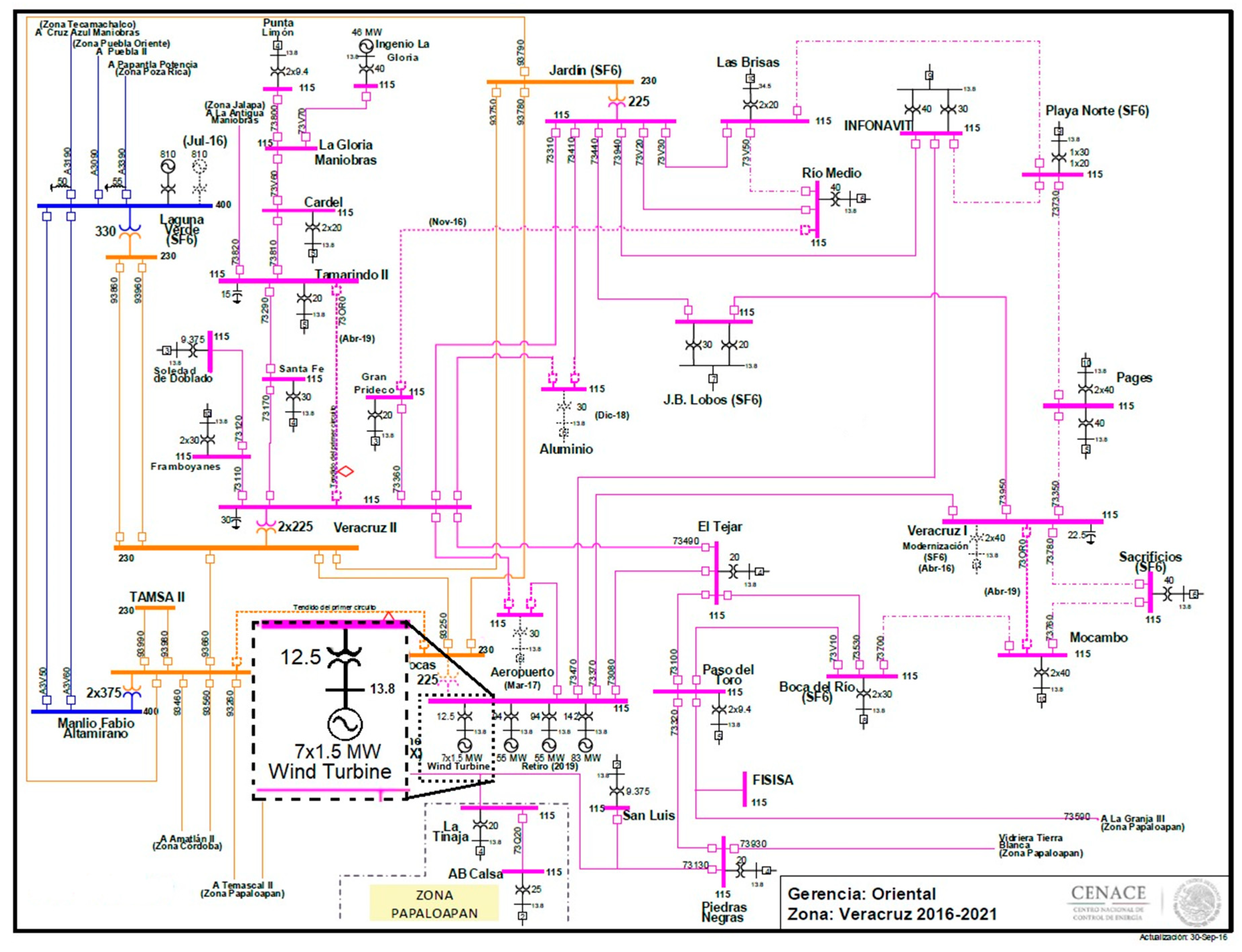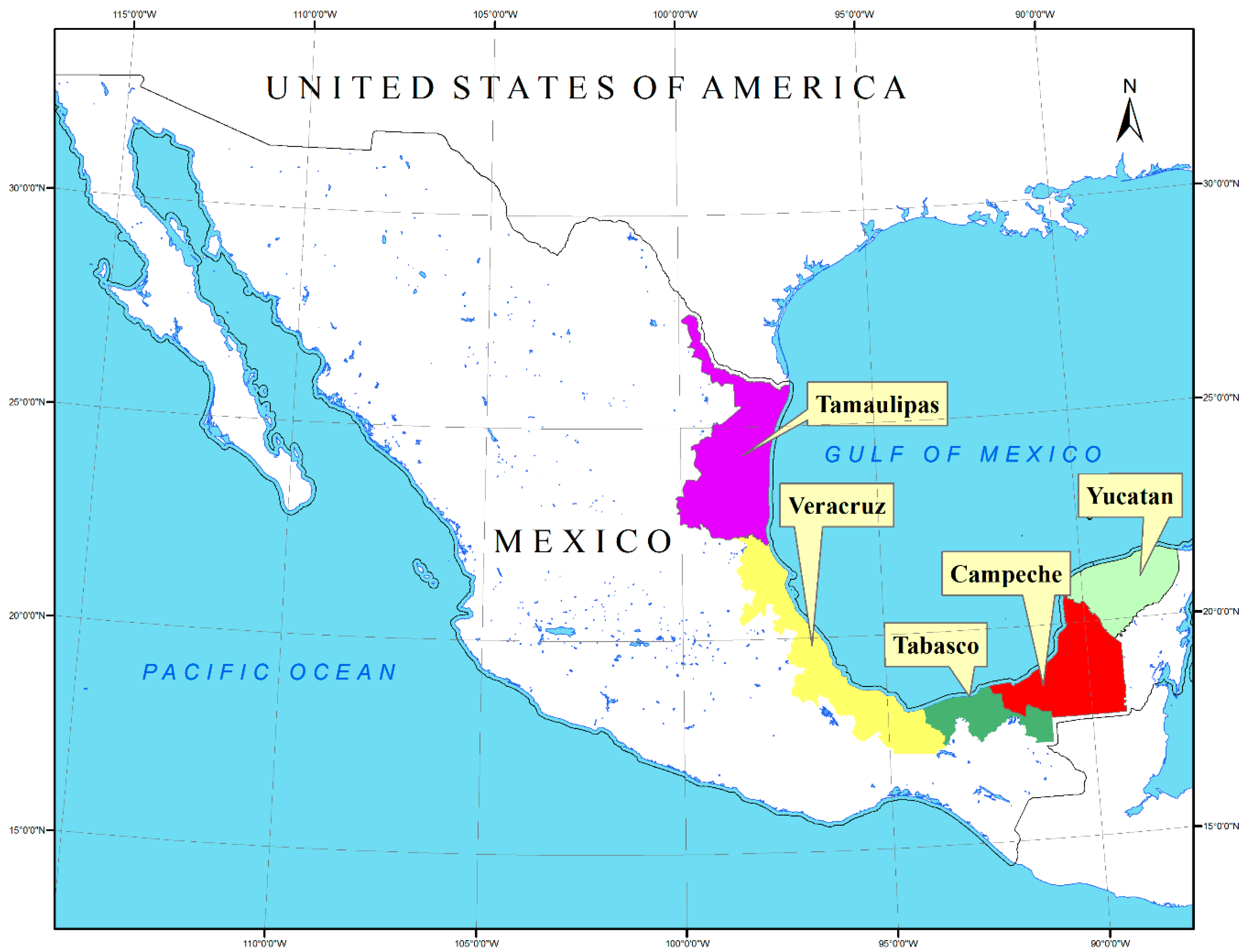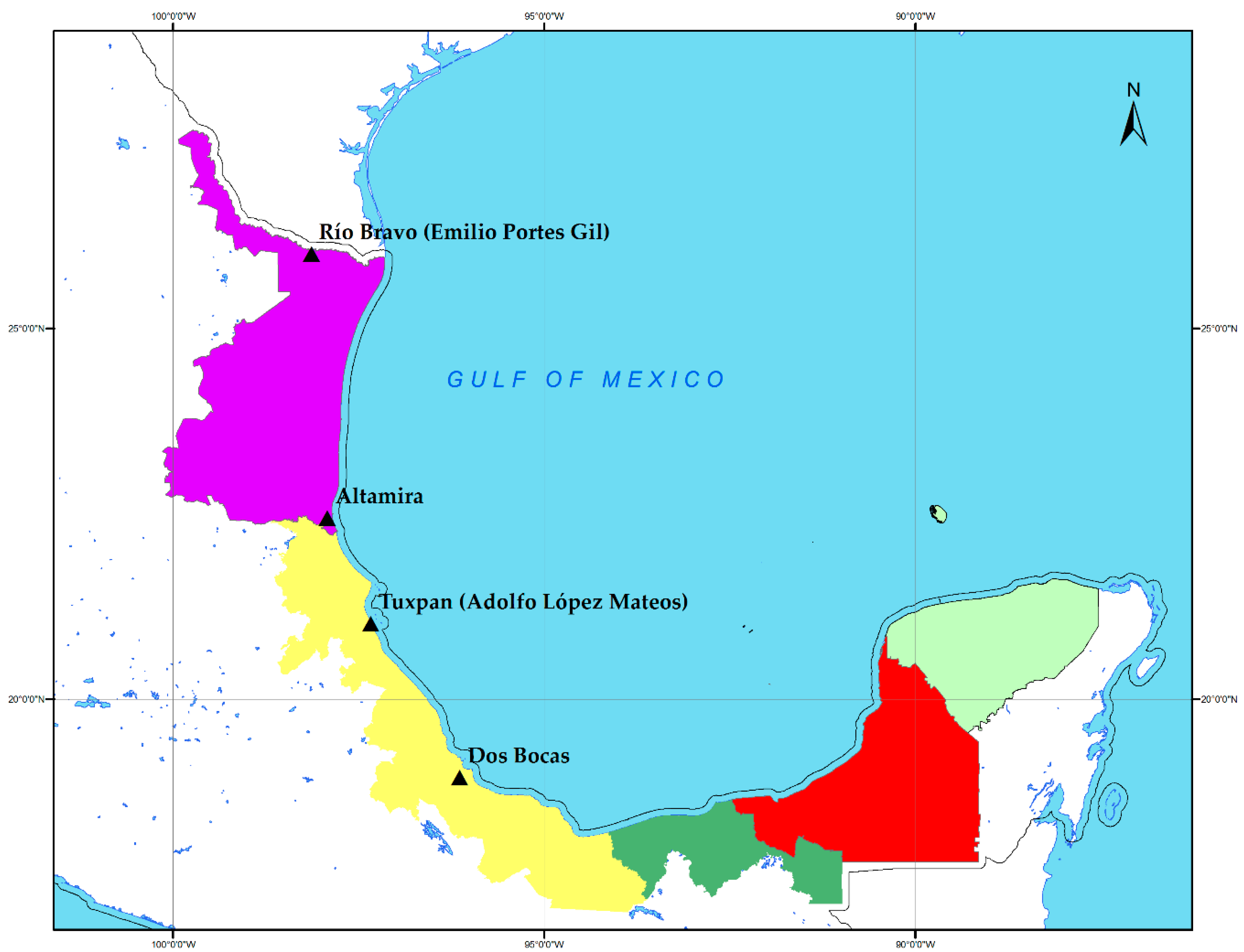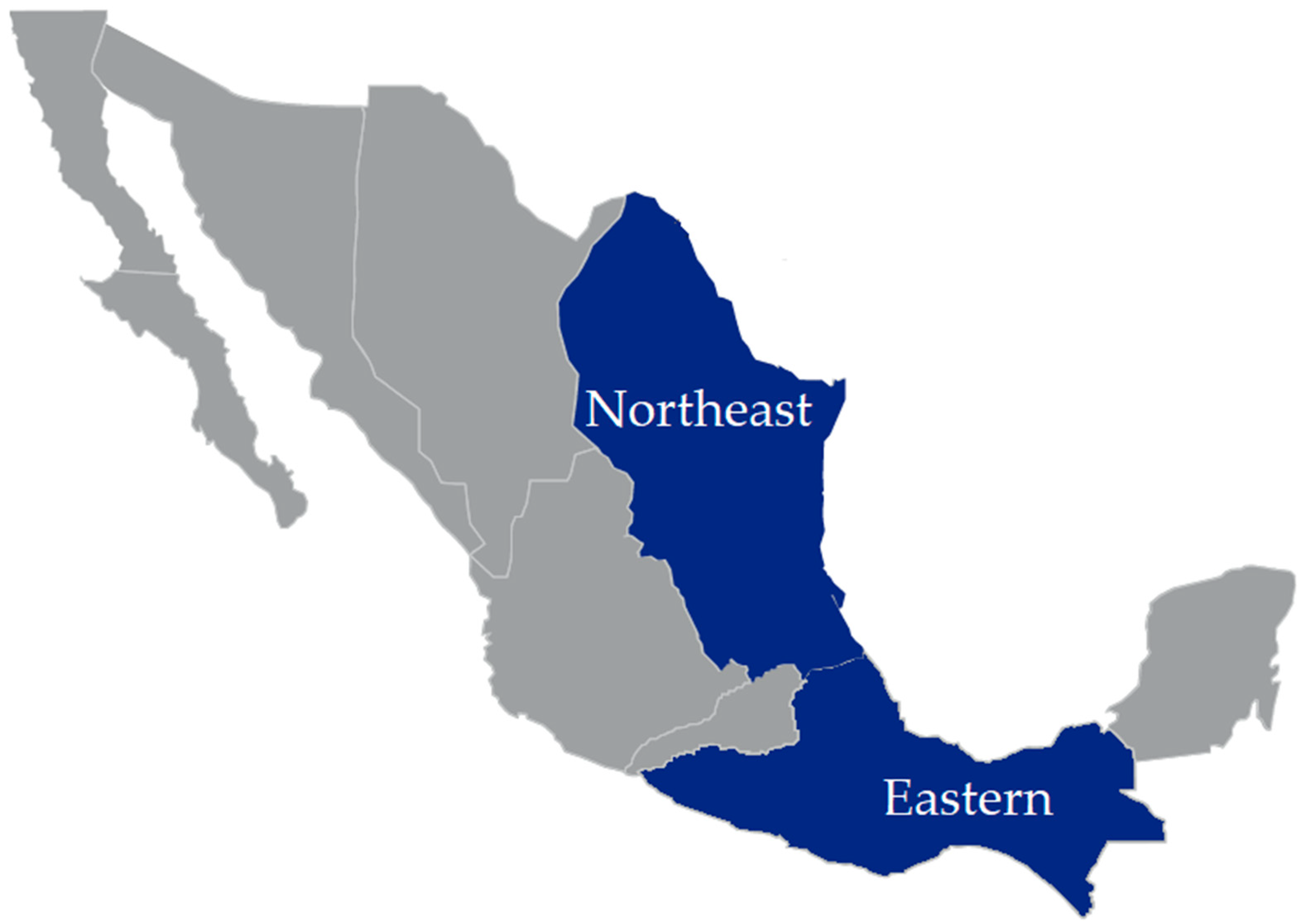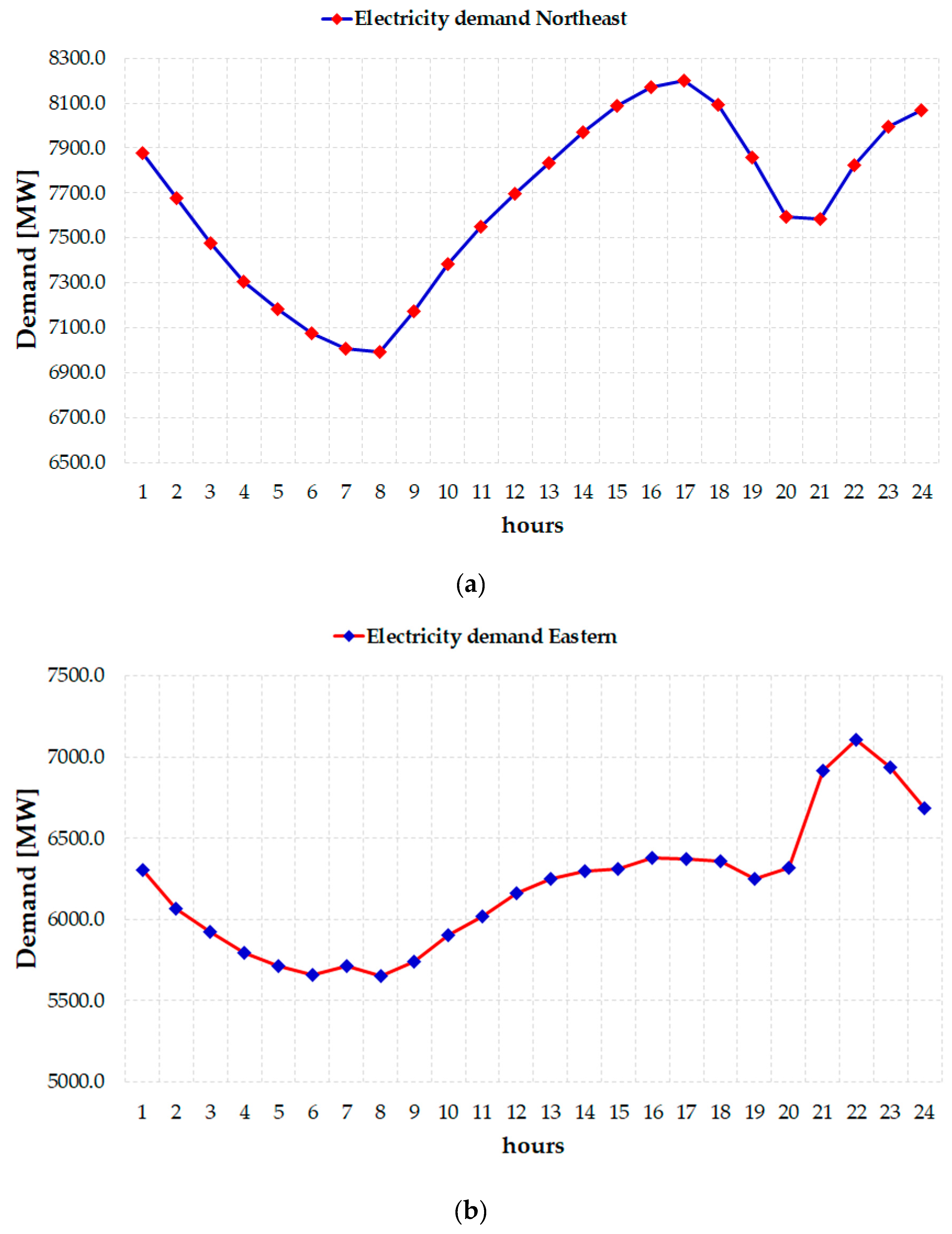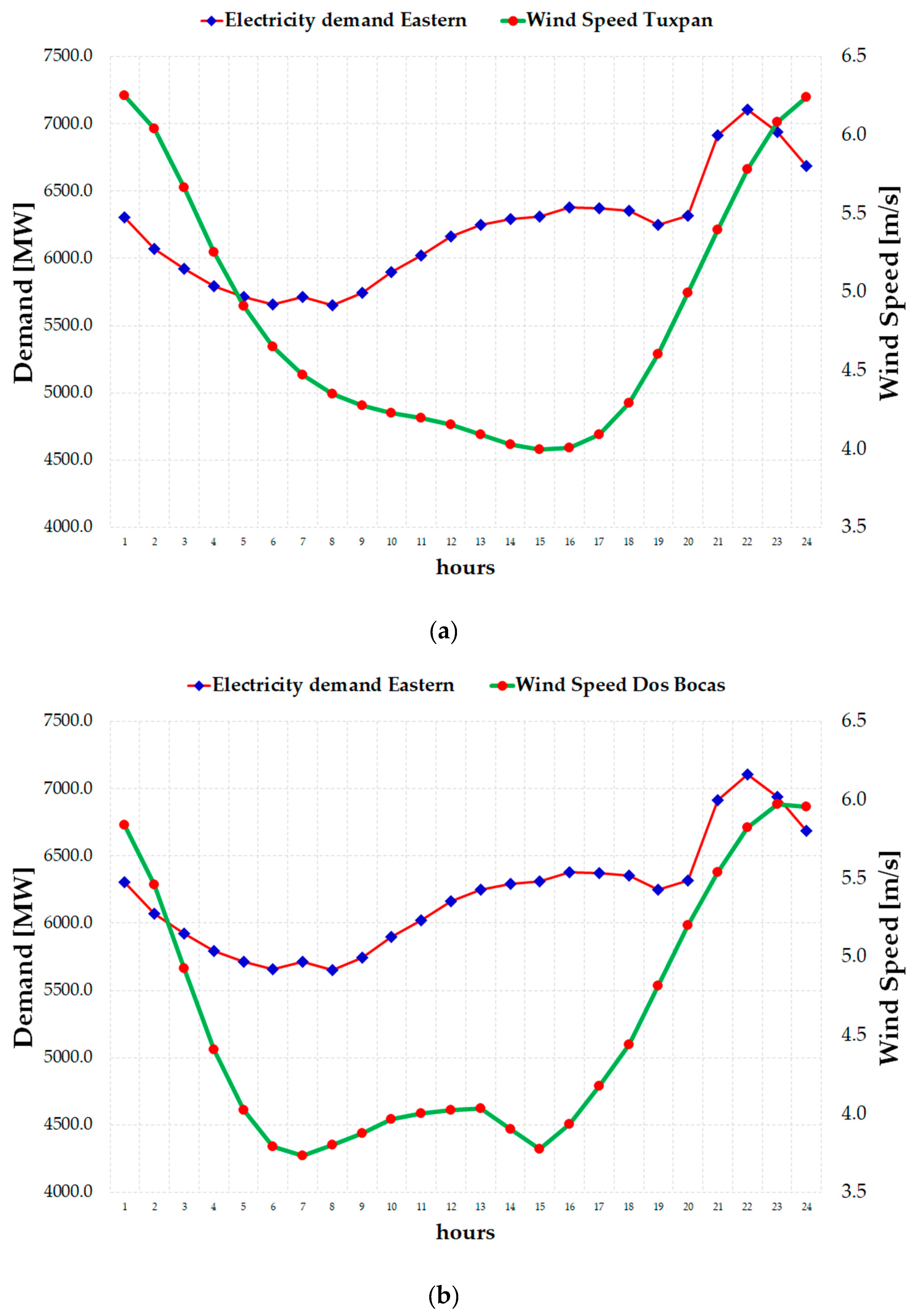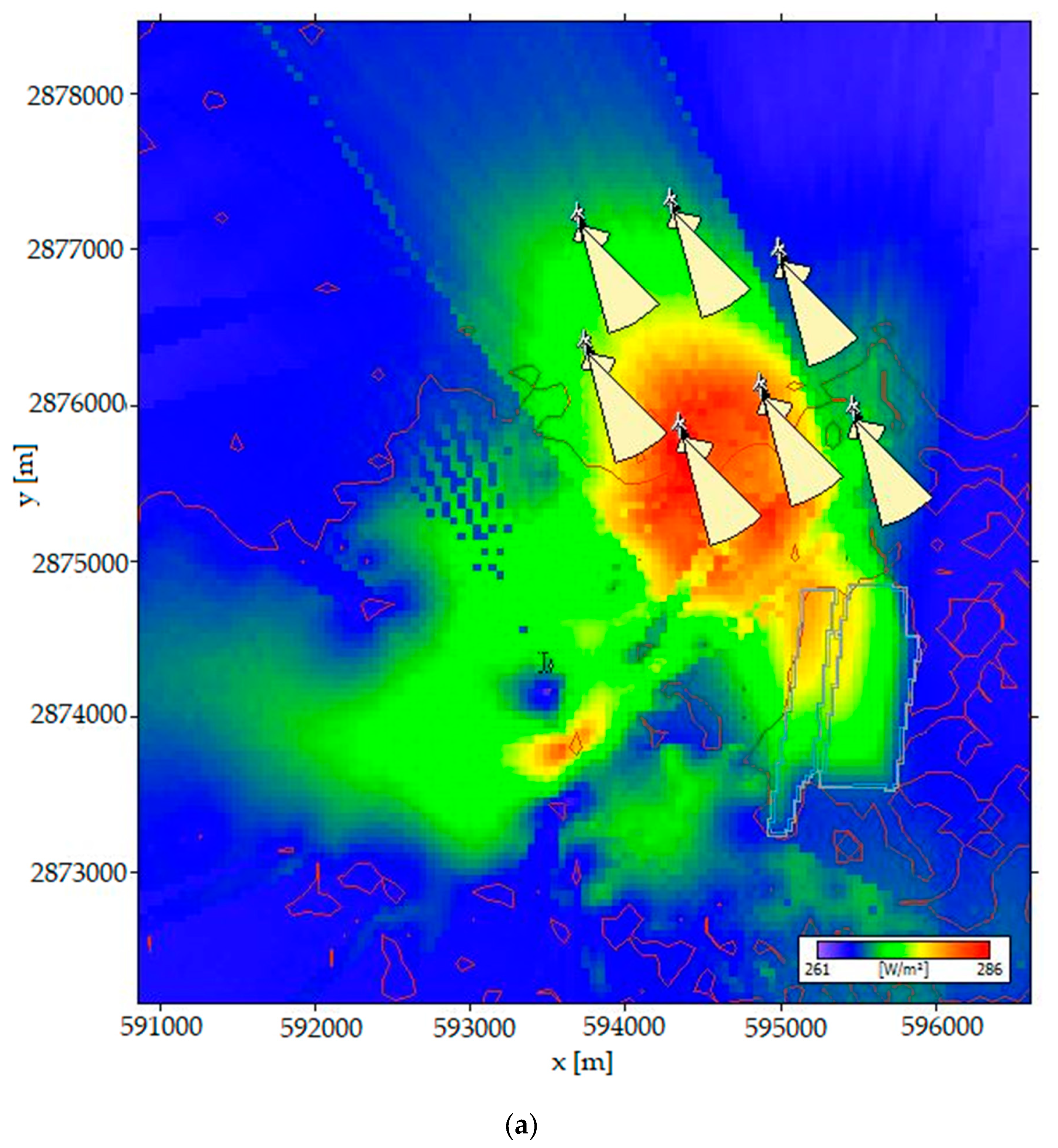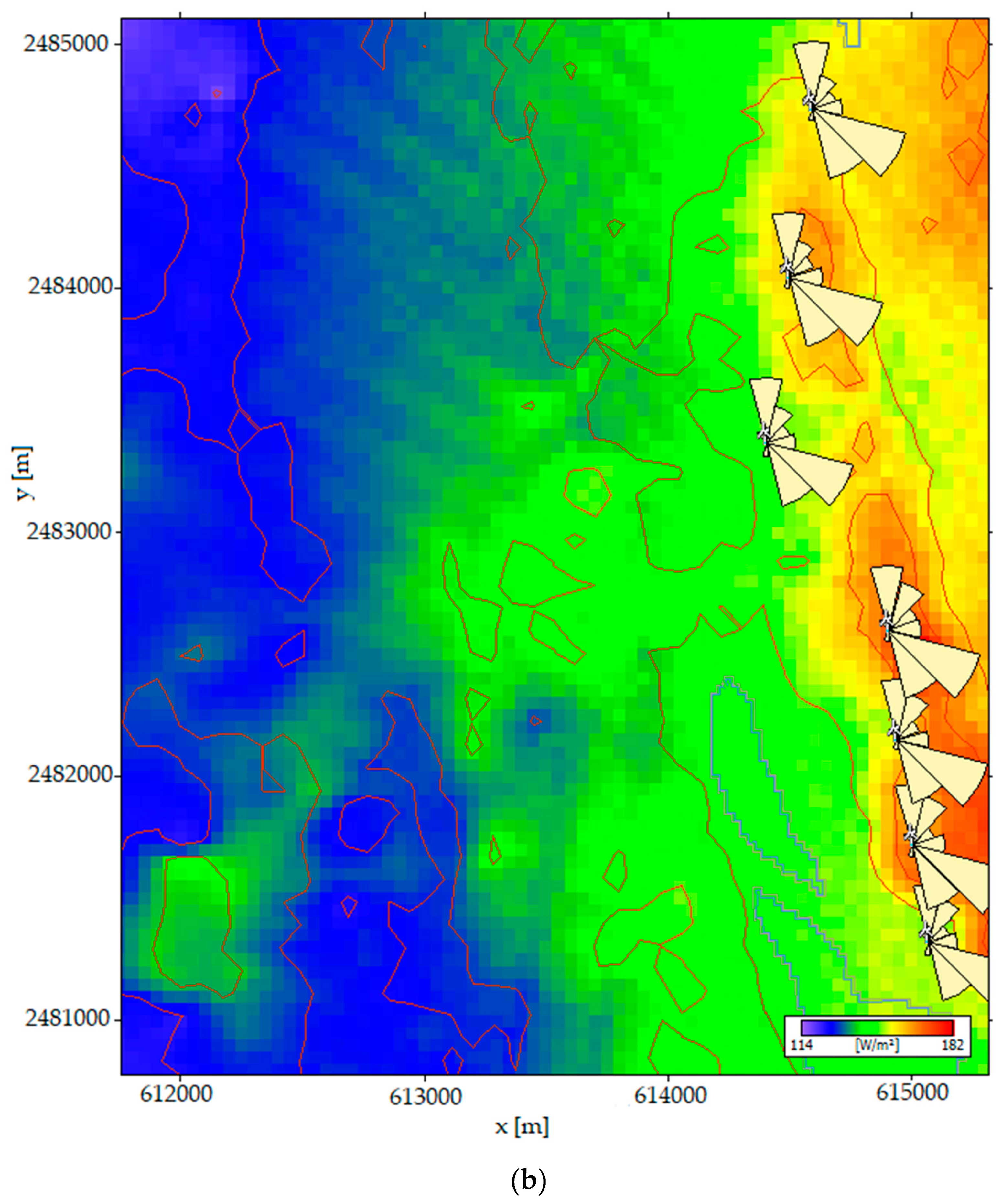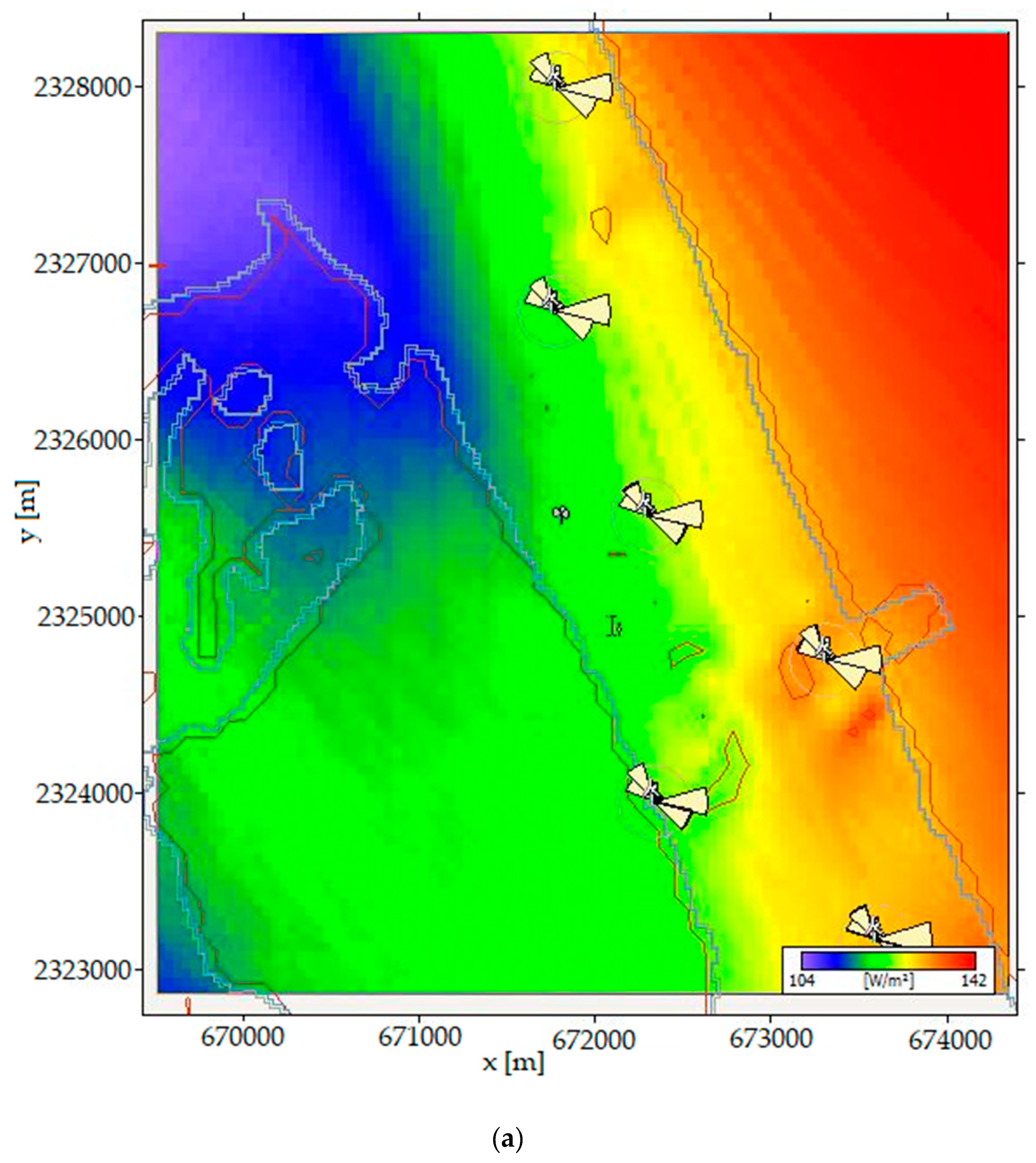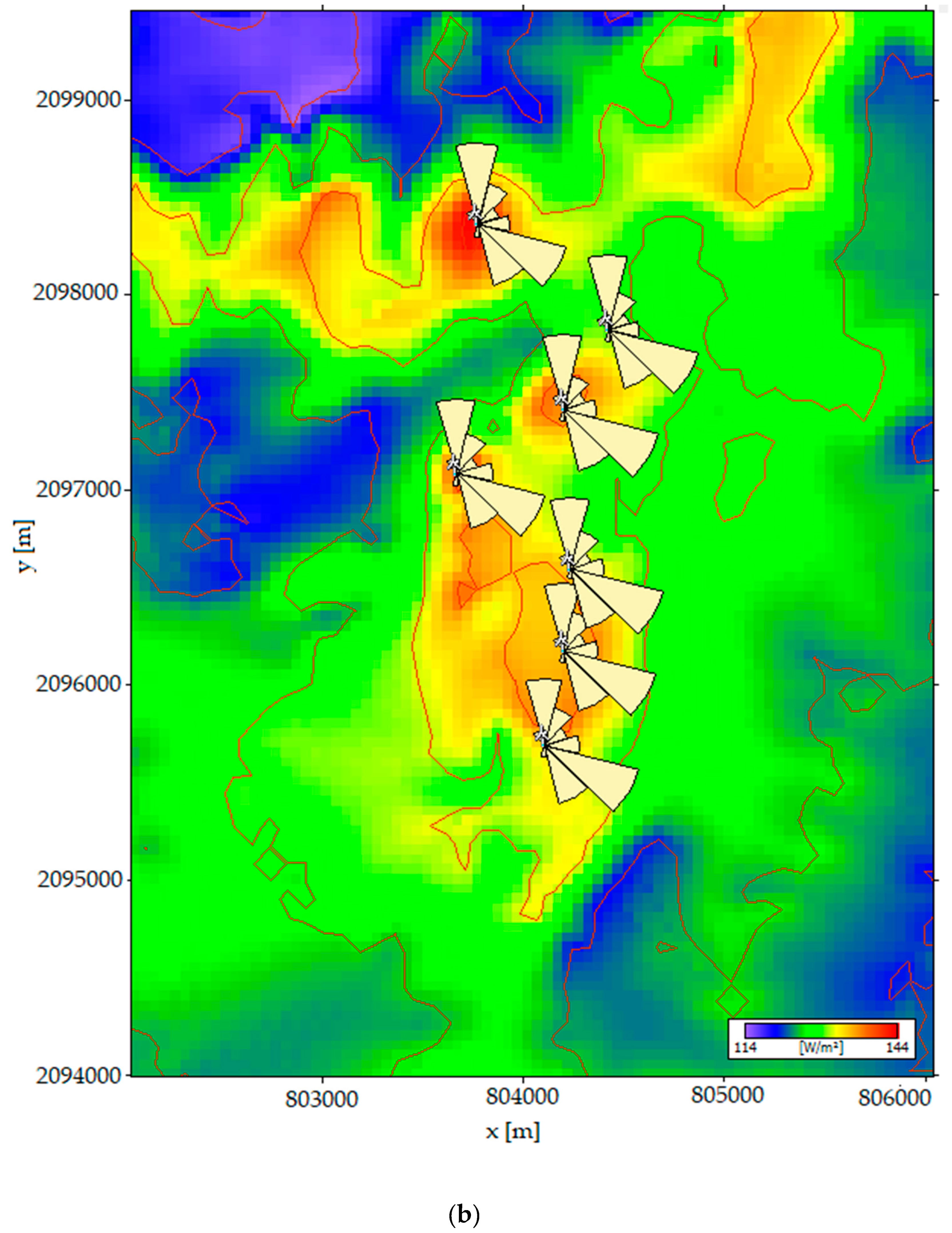1. Introduction
One of the world’s biggest problems is that population always is increasing and some countries have over dependence on energy generation. In the world, primary energy consumption growth averaged 2.2% in 2017, up from 1.2% last year and the fastest since 2013. This compares with the 10-year average of 1.7% per year [
1]. In 2016, generation from combustible fuels accounted for 67.3% of total world gross electricity production (of which: 65.1% from fossil fuels; 2.3% from biofuels and waste), hydroelectric plants (including pumped storage) provided 16.6%; nuclear plants 10.4%; geothermal, solar, wind, tide, and other sources 5.6%; and biofuels and waste made up the remaining 2.3% [
2]. It is known that energy supply side and demand side is essential to the correct usage of energy [
3], and this is important to nations because it depends on the effectiveness of its power systems and the availability of power supply at the load centers [
4]. It is important to define the concepts of load and electricity demand, on the one hand to understanding load of an electric power distribution as the final stage of the system that converts electric energy in another form of energy; respecting electricity demand is known as the electric power related on a period of time, that uses load to work.
In Mexico, electricity demand is considered decisive in social and economic development and consequently in the improvement of the economic conditions. The maximum demand for electrical energy occurs mainly during the summer season, between May and September, when the heat is more severe in the north and southeast of the country. As a result, the use of ventilation equipment is increased to maintain the temperature at more comfortable levels and the values necessary for the proper functioning of certain appliances are regulated. In 2017, the energy independence index, which shows the relationship between production and national energy consumption, was equivalent to 0.76. This result implies that the amount of energy produced in the country was 24.0% less than that which was made available in the various consumer activities in the national territory. In the course of the last ten years, this indicator decreased in an average annual rate of 5.0% [
5]. An alternative will be the use of renewable energy, the Transition Energetic Law establish a renewable energy minimal participation in electricity generation of 25%, 30% and 35% in 2018, 2021, and 2024, respectively [
6]. In the energetic mix, renewable energies have a participation of 14%, the technologies most used are hydraulic, and wind energy contributed with 3% or 38.23 PJ in 2017 [
7].
Peak electricity demand is a global policy concern which creates transmission constraints and congestion, and raises the cost of electricity for all end-users [
8]. Also, a considerable investment is required to upgrade electricity distribution and transmission infrastructure, and build generation plants to provide power during peak demand periods [
9]. This is important because usually service suppliers charge a higher price for services at peak-time than for off-peak time to compensate for the costly electricity generation at peak hours [
10]. Thus, if peak demand is reduced, electric system will be benefited. In addition to these benefits a study done by the authors of Reference [
11] determine that it can eliminate the need to install expensive extra generation capacity such as combustion turbines for peak hours which are less than a hundred hours a year. With this information regions will be considered where demand complies with the conditions to have the necessary hours. Another benefit is for consumers, because if they know the period of time of peak demand and decrease their consumption, they can avoid higher electricity prices. An option to reduce peak demand is installing peak plants but the economic benefit does not justify the investment. Usually these peak plants use fossil fuel and the result is more generation of greenhouse gases [
12].
The use of wind energy to support the electric demand mainly during its peak period is an alternative to reduce fossil fuel combustion and greenhouse gas emissions. Wind is intermittent and uncertain, which represents a problem in power systems [
13]. A study done by the authors of Reference [
14] established that due to the unpredictable nature of wind energy and non-coincidence between wind units output power and demand peak load, wind units are deemed as an unreliable source of energy. In this study a stochastic mathematical model was developed for the optimal allocation of energy storage units in active distribution networks in order to reduce wind power spillage and load curtailment while managing congestion and voltage deviation.
In New York State the intraregional effects were illustrated by quantifying the net load, net load ramping, operating reserve, and regulation requirements, the study found out that only at wind capacities exceeding 100% of the average statewide load does the wind-generated electricity meet significant portions of the distant demands [
15].
An improved energy hub system combined with cooling, heating, and power integrated with photovoltaic and wind turbine, demonstrated that operation cost and carbon emission were reduced by 3.9% and 2.26%, respectively [
16]. In Canada a battery storage system to minimize the energy drawn from the public grid was proposed This storage system was charged from wind turbines and the energy stores were discharged to a park when the wind park power dropped below 0 kW and the storage system was able to offset 17.2 MWh but the financial gain was insufficient to offset the net energy losses in the storage system [
17].
About cogeneration, in China Reference [
18] established the relationship between a wind farm and a thermal power plant, in this study the difference between wind power profits and thermal power is only analyzed in terms of cost differences, and no comparison of other data is involved. According to this, the specific example of Gansu Province not only shows the difference in earnings before and after the peak-to-peak adjustment of wind power, but also indicates that the large-scale auxiliary adjustment of wind power can ensure that thermal power generators can participate in deep-peaking with reasonable returns; Reference [
19] analyses and compares several existing kinds of distributed energy storage for improving wind power integration. Then considering a mass of cogeneration units in north China, control strategy for wind power integration is proposed to reduce the peak regulation capacity for wind power integration. As a result, the peak–valley load difference can be equivalently reduced to relieve peaking pressure for wind power integration.
In Northern China a proposal were made suggesting that if the energy carrier for part of the end users space heating is switched from heating water to electricity (e.g., electric heat pumps can provide space heating in the domestic sector), the ratio of electricity to heating water load should be adjusted to optimize the power dispatch between cogeneration units and wind turbines, resulting in fuel conservation, they found out that with the existing infrastructures are made full use of, and no additional ones are required [
20]. Bexten et al. [
21] investigate a system configuration, which incorporates a heat-driven industrial gas turbine interacting with a wind farm providing volatile renewable power generation. The study quantifies the impact of selected system design parameters on the quality of local wind power system integration that can be achieved with a specific set of parameters. Results show that the investigated system configuration has the ability to significantly increase the level of local wind power integration.
In this study a methodology is proposed, which consists in locating thermal power plants along the five states of the Gulf of Mexico (Tamaulipas, Veracruz, Tabasco, Campeche, and Yucatan) and evaluating wind resources next to these plants with the objective to determine the power output generated and their contribution to reduce the peak electricity demand. For the geographic position of Mexican states along the Gulf of Mexico, see
Figure 1.
4. Conclusions
The microscale model increased the accuracy of wind assessment to place wind farms. This is because when running the microscale model, several variables are taken into account such as roughness, orography, and climatology. In this study, four sites were assessed to model wind farms using MERRA-2 data, wind speed, wind direction, temperature, and atmospheric pressure, with records from 1980–2018.
The electricity that wind farms generate is delivered over transmission and distribution power lines. High-voltage transmission lines carry electricity over long distances to where consumers need it. More distance means more losses. The amount of power produced by each wind farm could contribute to the power produced by a thermal plant. In total for Northeast region they can deliver to the grid 2657.02 MW at peak demand. If there is 8000 MW demanded at this moment, the reduction will be at 5342.98 MW. At the Eastern region, the thermal power plant called Tuxpan is the biggest one in Mexico, so the amount of power in both wind farms and thermal plants is higher than Northeast. In this case, the total production is 3196.18 MW, and peak demand power delivered is 7200 MW if wind farms and thermal power plants work at the same time. The amount of power at this moment will be 4003.82 MW. There could be several techniques to contribute to decreased peak demand, energy storage technologies, and faster response times, but the most important is to nurture future generations.
The impact of the thermal power plants, once they have the contribution of wind energy, can be considered as follows: the efficiency for Rio Bravo and Altamira could be 31% and for Tuxpan and Dos Bocas 47%; the capacity factor, 36% and 56% respectively, however, the volatility and availability of wind in the entire year must be considered.
Mexico’s main objective is to reach 35% of its electricity generated by clean sources in 2024. Employing this type of generation is important to contemplate both the trajectory of electricity demand and wind speed and to avoid a duck-curve that represents several renewable sources being contributed during the day but not at night, as solar or when wind does not has enough potential, e.g., Northeast curve has two peaks during the day, the first one peak is at 17:00 h and the second one is at 24:00 h, at this hour solar energy cannot be consider and if at this time does not flow the wind, the peak demand will increase and the prices will also do it.
